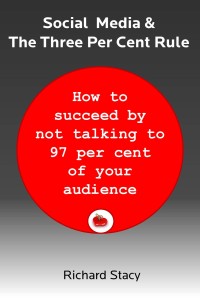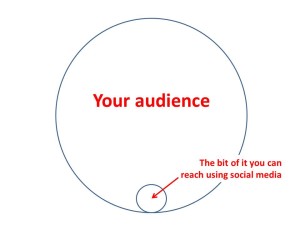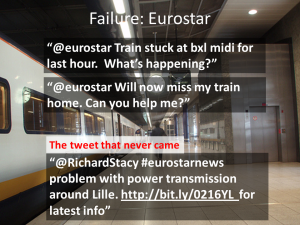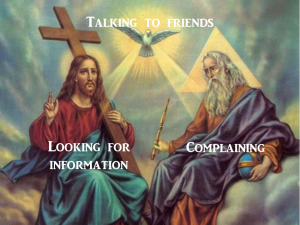 A couple of weeks ago I took part in an interesting experiment at the Marketing Week Live show at London’s Earls Court. The instigators of the experiment were Collaboration Matters and IBM and the purpose of the experiment was to try and dramatise the role of digital community in influencing retail behaviour. The set for the experiment was a stand at the show ‘selling’ top-end fashion womens’ shoes, constructed as part-catwalk, part-high street store. The slightly more commercial purpose of the experiment was to try and create a presence that was markedly more engaging to those attending than the bog-standard trade show display.
A couple of weeks ago I took part in an interesting experiment at the Marketing Week Live show at London’s Earls Court. The instigators of the experiment were Collaboration Matters and IBM and the purpose of the experiment was to try and dramatise the role of digital community in influencing retail behaviour. The set for the experiment was a stand at the show ‘selling’ top-end fashion womens’ shoes, constructed as part-catwalk, part-high street store. The slightly more commercial purpose of the experiment was to try and create a presence that was markedly more engaging to those attending than the bog-standard trade show display.
As an experiment, it certainly worked in the later aspect but it also highlighted some important truths about the role and relevance of consumers and digital community. In my opinion, these were:
- The consumer cannot be considered as simply an individual any more. The consumer is now a connected individual whose decisions are influenced by the communities of which they are a part.
- These communities can vary from close and fixed communities of friendship, communities defined by providing answers to specific questions, through to very loose ‘Google communities’ where we tap into collective intelligence.
- Brands cannot expect consumers to join brand communities, rather brands have to understand what role they have, if any, in participating in consumers’ communities.
- The role for community, with a brand, is to create an internal community based on fostering the behaviours necessary to have an effective relationship with the connected consumer.
The whole ‘story’ of the event was pulled together by Mike Morrison on Storify – you can see it here.
Just because you can doesn’t mean you should
It was good to be at the event and see the experiment in action, and also to talk to some of the other participants and organisers; Marie Wallace from IBM’s social business unit, Mike Morrison, Will McInnes from Nixon McInnes and Rooven Pakkiri and Dale Roberts from Collaboration Matters.
One of the discussions stands out. Marie was talking about the goal for technologists, such as IBM, and brand owners or retailers. This was the possibility of extending the environment within which brands can have contact with a consumer – reaching backwards to whatever triggers an interest or desire in a product and forwards, beyond purchase, into creating brand loyalty and repeat purchase. Essentially, this was an examination of where social technology can be overlaid onto the classic consumer journey, opening up many more opportunities than those which exist with the traditional one-to-many marketing process.
From a retail perspective we were focusing on what needed to happen to ‘seal the deal’ i.e. make sure that the retailer was able to create an environment that would lead to a purchase decision, either through increasing the numbers of people through the door with a high propensity to purchase or through the ability to supply information that would help the retailer convert a sales prospect.
As we sat there, we were starting to imagine a future world where a woman would walk into a shoe shop, and she wouldn’t be just another person off the street, she would come surrounded by a digital cloud which would interact (or had already been interacting) with the digital persona of the shop itself, such that the shop assistant would be able to have the pair of shoes she was interested in, plus the two alternatives her friends had suggested, ready and waiting for her. Or alternatively, said shop assistant would be able to weave information about the prospect into the sales conversation, based on knowledge about what celebrities she may admire, what bands she followed etc.
All very exciting stuff and certainly something which is coming within the technical competence of organisations such as IBM. But as I sat there, I started to wonder if the real barriers to be overcome here were not technical ones, they were social ones. While it might be technically possible to know and analyse a huge amount of data about an individual, is it socially possible to use this information? It is not a case of what you know, it is how you got to know it.
Here is an analogy from dating. Within the world of dating there are established rules and processes that are basically designed to help two people find out about each other and thus work-out if they have the basis for a relationship. Interestingly, it is possible for any one of the protagonists to find out much more about the other besides the relatively restricted palette of ‘data’ which might be offered-up on a date. They could spy on them through their windows with a telescope. They could go through their rubbish bins. They could follow them around for a while and see what they do and who they hand-out with. But while this is behaviour which is technically possible, it is behaviour which is socially unacceptable. And even if you can do it without detection, to reveal knowledge of information thus gleaned is to court social disaster.
It seems to me that a lot of what we are talking about here is basically the equivalent of digital stalking. Brands are proposing to use technology to find out information about people for which they have not been granted social permission. And the reaction of the consumer is not going to be “hey, how amazing that X brand knows so much about me that it can offer me such a uniquely personalised brand experience” it’s going to be “go away and stop spying on my life”.
The great thing about advertising is that no-one takes it personally
We need to redefine the rules of permission within social marketing. Within traditional marketing these were relatively clear, in that we actually had permission to be crass and intrusive. Interrupting a TV programme with an ad is pretty intrusive, but consumers accepted that there was a trade-off here. Also, consumers could accept such behaviour because it was never intended to be taken personally. However, as soon as you create personalised approaches, you can’t be surprised if consumers start to take it personally. In the world of personalised behaviour a whole different set of rules therefore apply – social rules. Marketing has never been social, indeed the term social marketing could be seen as an oxymoron.
It is interesting to note, as this piece by Doc Searls points out, that digital advertising becomes less efficient, the more targeted it becomes. It seems as though at a certain level of personalisation, advertising stops working. It is as though a boundary has been crossed. On one side of that boundary a consumer will accept advertising on the basis that this is designed as a piece of communication intended for them as an anonymous individual who is part of a large group. On the other side of that boundary, people are in effect saying now you have crossed this fence new rules apply. Your advertising either has to be hugely more relevant (in a way that probably means it can no longer be classified as advertising) or else you have to have a proper relationship with me as an individual. The intrusive rules and behaviours of mass marketing are simply not acceptable if you want to make it personal.
I think that studying and understanding this boundary is the single most important thing marketers need to do and the role of the technologists should be to help them do this, rather than providing them with the tools that help them spy on their consumers. There seem to be two issues here. One is establishing how and when a brand has the permission to recognise a consumer as an individual and the other is helping a brand adopt appropriate behaviour once that permission has been granted.
Understanding the new rules – what marketers should learn from the Spice Girls
I think the most important recognition principle is that the consumer has to give an explicit indication that they are willing to accept a personalised approach. At one level this could be very obvious in that they have posed a question directly to a brand and are expecting a specific response. This is the sort of thing that basic monitoring capabilities can currently pick-up. However, the area of probably the greatest opportunity, but also difficulty, lies in interpreting the more subtle and sophisticated signals a potential consumer may give-off. But the key is recognising that this cannot be a deductive process – i.e. because we know that you as a consumer have done A, B and C that therefore means you have given permission for D. A consumer cannot be surprised, pleasantly or otherwise, by an approach – they will need to be able to make the link between cause and effect.
It is also important to recognise that just because a consumer is giving the right signals, this doesn’t mean they have surrendered the right to anonymity. To return to the dating analogy, just because someone has agreed to go out for a drink doesn’t mean they have given permission for the content of their bins to be examined. Consumers will expect to retain control over what information they surrender and even if a brand has already been able gather data about them, the consumer will not expect to see this data coming up in the conversation and might possibly end the relationship if they see it appearing.
This brings us onto the issue of behaviour and also onto the Spice Girls. Back in 1996, when the Spice Girls were telling us what they wanted (what they really, really wanted) . They said “If you want to be my lover, you gotta get with my friends”. What they were really, really saying is that they can no longer be treated as an individual, they are now part of a community. Power comes through connection – Girl Power in this instance. And the explicit instruction to those that wished to be their lover was that they had to ‘get with’ that community. The Spice Girls also gave further instruction. “So what do you think of that now you know how I feel, can you handle my love, are you for real? I won’t be hasty, I’ll give you a try, but if you really bug me then I’ll say goodbye”.
I think all marketing directors should pin those lyrics above their desks .
The net effect of this may well be that there is a big consumer space that will become a DMZ – a de-marketingized zone – into which brands cannot go except with very explicit permission and subject to very stringent rules of respect for community behaviour. If they can’t handle that, if they are not for real and if they bug people, they will get thrown-out. In this space, the individual consumer is almost beyond direct reach – they can only be accessed through the communities which act as their gatekeepers.
This takes us to the role of brand communities. Brand communities will have a very, very tough time trying to establish themselves in the DMZ. This is not to say that they won’t exist, but their role has to be 100 per cent focused on supporting what it is that consumers want a community to do. In reality, and this is something that the experiment at the show demonstrated, the most powerful role a brand community can fulfill is as an internal community within the brand’s business that helps create appropriate external behaviours.
I suspect that the social enterprise tools that will become successful will be those that help businesses understand and operate within the communities of their consumers or customers. Rather than exploit the ability to crunch data about individual consumers, they will exploit the ability to develop and share intelligence about collective consumer behaviour. They will help brands understand the community in order to understand the individual.
 One of the great things about the social digital space is that it allows people to cultivate their obsessions while benefiting society as a result. Before going any further, I should stress that there are, of course ways in which obsessions can also be cultivated in this space that do great damage to society, but I don’t think this fact should be used to obscure the positive advantages of obsessional behaviour – for they exist.
One of the great things about the social digital space is that it allows people to cultivate their obsessions while benefiting society as a result. Before going any further, I should stress that there are, of course ways in which obsessions can also be cultivated in this space that do great damage to society, but I don’t think this fact should be used to obscure the positive advantages of obsessional behaviour – for they exist.


 The group I was talking to (early twenties graduates) comprised people who are probably the most engaged with social media generally. If we were talking an audience more typical for most consumer products we would more likely find that one in 30 (i.e. three per cent) coming in at somewhere closer to one per cent. This is, of course, just one sample – but I expect that the numbers I was generating hear are not wildly out of line with a more general case. In fact, I am tempted to do a bit of work to try and bear this out.
The group I was talking to (early twenties graduates) comprised people who are probably the most engaged with social media generally. If we were talking an audience more typical for most consumer products we would more likely find that one in 30 (i.e. three per cent) coming in at somewhere closer to one per cent. This is, of course, just one sample – but I expect that the numbers I was generating hear are not wildly out of line with a more general case. In fact, I am tempted to do a bit of work to try and bear this out.
 (This was published in the print edition of Digital Age in Turkey earlier this month. It also appeared as few days later as a
(This was published in the print edition of Digital Age in Turkey earlier this month. It also appeared as few days later as a 


